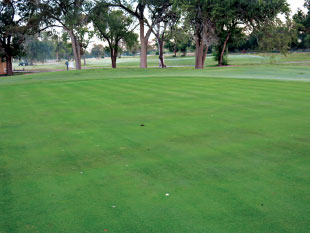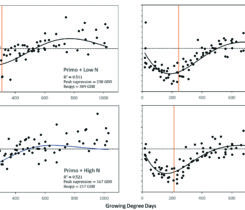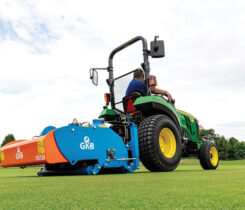Suppression of Creeping Bentgrass With Sequential Applications of PGRs

Image from Aug. 13, 2014, illustrating the darker green color observed with applications of plant growth regulators containing paclobutrazol compared with other products or control treatments.
Some superintendents in Texas struggle with excessive shoot growth of creeping bentgrass (Agrostis stolonifera L.) in the summer, resulting in poor performance. Plant Growth Regulators (PGRs) are commonly used on greens to limit this.
The objectives of this study were to determine the growth suppression potential of sequential applications on creeping bentgrass putting greens and to evaluate putting green performance. Moderate rates of PGRs were applied in April 2014. The products containing paclobutrazol resulted in severe phytotoxicity that reduced turf quality and green cover below 50 percent. Heavy rainfall and warmer temperatures in May increased growth rates, and all treatments receiving paclobutrazol recovered quickly, becoming similar to untreated controls and other PGRs.
Additional applications of PGRs containing paclobutrazol never resulted in green cover diminishing below 85 percent. These same products significantly increased dark green color index throughout the study. Sequential applications were made every two weeks, but growth suppression from applications was not observed for 2-4 days following application.
Rebound effects were observed in June and July when applying the lowest label rates of PGRs. The application of PGRs at the lowest label rate to rebounded turf suppressed growth by 30 to 40 percent as expected, but will only reduce clipping yields to the level of the untreated control unless higher rates of PGRs are used. Increased shoot growth in July and August warranted higher application rates that increased suppression. The moderate rates applied every two weeks sustained 20- to 50-percent suppression compared to untreated controls.
We found that low rates of PGRs during moderate growth periods effectively suppressed shoot growth with limited quality and cover reductions. However, in order to maintain acceptable quality and playing conditions, moderate rates were required every two weeks when growth rates increased later in the summer months.
Photo: Joseph Young










